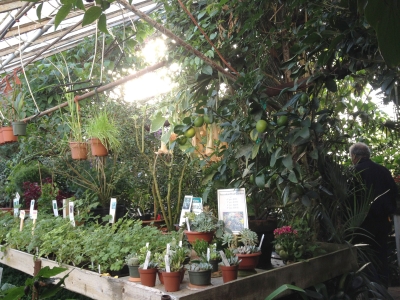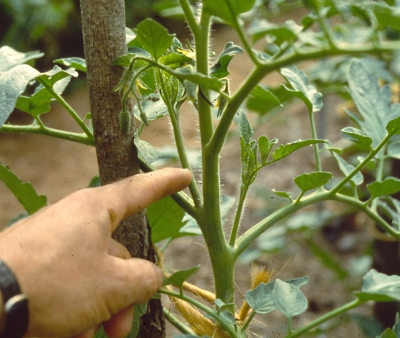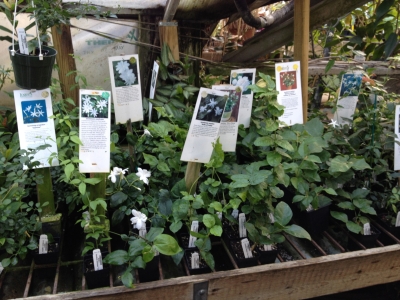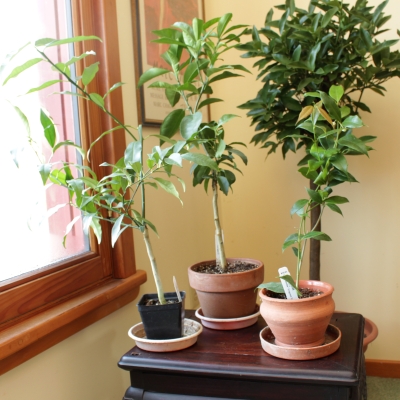CITRUS IN NEW YORK
/1 Comment/in Fruit, Gardening, Houseplants/by Lee ReichParadise Under Glass, and I Take a Bit of it Home
Wandering in and out of the narrow alleys, I could barely squeeze past other, potential buyers. On my way back from a lecture and book selling, a wad of money was burning a hole in my pocket. I muttered to a young couple who glanced up to let me pass, “I feel like a drug addict.” A fleeting, sympathetic smile, and they, like others, were again intent on the offerings, hardly aware, like us other “addicts,” of other humanity.
I was lucky, able to leave Logee’s Greenhouses in Danielson, CT only $75 poorer. But richer in plants. Perched on the tray that I carried to my car were small plants of fragrant wax plant (Hoya odorata), Nordmann Seedless Nagami kumquat, and Golden Nugget mandarin (tangerine), all three promising to offer, for years to come, sweet fragrance, beauty, and good eating in the case of the mandarin and kumquat. By not allowing myself to dawdle, I was able to keep my trembling hand from grabbing at a Black Mission fig plant, a Dwarf Cavendish banana plant (“only 3 feet high!”), or a Hoya lauterbachii, with fragrant blooms the size of teacups.
Most of Logee’s plants are small and not cheap, understandable considering the wide array of plants they stock. Aside from my kumquat and mandarin, I could have chosen from among a dozen other citrus varieties, including some interesting oddities like Buddah’s Hand Citron, whose fruit does, in fact, look like the draped fingers on a hand. Instead of the fragrant wax plant, I could have driven home with any one of 15 other species or varieties of wax plant. Not that Logee’s is limited only to fragrant or fruiting plants. They stock almost a 100 different kinds of begonias, among other houseplants.
Entering the greenhouses is an experience very unlike that of entering most commercial greenhouses, the latter with their soaring roofs of crystal-clear glass, their buoyant atmosphere, and scoured concrete floors. Logee’s is Paradise for plant lovers, with a mix of concrete and dirt paths so narrow that leaves and tendrils grab at you from either side. Fortunately, plants are more organized at Logee’s than in Paradise: collections of such plants as citrus, passionflower, orchids, and angel’s trumpets are each grouped together. Perhaps the star of the show is the Ponderosa lemon tree, shipped by train then horse and buggy to the greenhouse in 1900 and still bearing crops of grapefruit sized lemons (also called American Wonder lemon and thought to be a hybrid of lemon and citron, originating as a seedling the 1880s). Over the years, it’s given rise to numerous offspring, one of which you can purchase, growing in a 2.5” pot, for $11.95.
Citrus: New Plants from Old
New plants of Ponderosa lemon and other citrus varieties can be propagated one of three ways.
Lemons and limes tend to root easily from cuttings, which are leafy branches with their bases plunged into a moist rooting medium such as a 1:1 mix of perlite and peat moss. Because citrus are evergreen, air around the cuttings has to be kept humid enough so the still-rootless stems don’t dry out. A clear plastic or glass tent does the trick. The leaves need to photosynthesize so they have energy to make roots, so some light is needed. Not too much, though, or the cuttings cook in their tent.
Special rooting hormones, which are synthetic analogues of natural plant hormones, help cuttings to root. Synthetic hormones are used because they decompose more slowly than natural hormones (and in different concentrations, are used as herbicides, such as 2,4-D). Another possibility is to soak the cuttings in water in which have steeped stems of willow, a plant that roots very easily so presumably has some root-stimulating goodies to share. I avoid the hassle of natural or synthetic hormones in rooting cuttings and, instead, pay careful attention to which stems I select for rooting, the rooting medium, and light.
Some citrus varieties can be propagated by seed. Usually a seed-propagated fruit gives rise to a baby different from the mother plant, reflecting the jumbling around of chromosomes as pollen and egg cells united. However, a few plants, and many citrus, exhibit apomyxis, where the seeds, although they look like normal seeds, are formed from cells of only the mother plant.
All the seedlings, then, are clones of each other and their mother. Well, not all, because in a given fruit, some seeds may be apomyctic and others may be the product of pollination. The apomyctic seedlings show their presence by their greater vigor and more upright stature.
Downsides to propagation by seedlings, apomyctic or otherwise, are that plants must go through a juvenile phases of some years before they are old enough to flower and fruit. Also, most citrus tend to be very thorny in their youth.
Kumquats Roots for Tangerine Tops
One way I justified my purchases at Logee’s was with my plan to use my new citrus plants to make more plants — by grafting, the third way of propagating citrus. All that’s needed is any citrus rootstock; they all are graft compatible. Not being able to throw away seeds, I have a few kumquat rootstocks started from seeds I spit out from my Meiwa kumquat fruits as I ate them a couple of years ago.
I’ll graft in spring, taking stems from the Golden Nugget mandarin to make a whip graft, a particularly easy kind of graft that gives quick results. Basically, a smooth, sloping cut on the kumquat rootstock will be matched against a similarly smooth, sloping cut on the “scion,” which is the stem I cut from the mandarin stem, with both bound together with a wrap of tape or cut rubber band. After removing leaves from the scion, grafting compound (Tree-Kote) or Parafilm seals the graft and scion against dessication before the scion and rootstock knit together, and the scion piece begins to grow.
The final step will be deciding what to do with my growing citrus orchard in pots. Plants for my annual sale, perhaps? The largest citrus orchard (potted) in the Hudson Valley?
It’s Summertime, on a New Video
/2 Comments/in Gardening/by Lee ReichWould you like to be transported back to summer, for 4 minutes at least? Check out my newest video post, at https://leereich.com/video
Who’s the Best Gardener/Farmdener?
/3 Comments/in Fruit, Gardening, Soil, Vegetables/by Lee ReichFresh Watermelon, and More, with Help from Ethylene
Could I possibly be the best gardener west of the Hudson River? Perhaps. As evidence: On November 1st, here in Zone 5 of New York’s Hudson River Valley, where temperatures already have plummeted more than once to 25°F, I was able to harvest a fresh, dead-ripe watermelon. Not from a greenhouse, not from a hoop house, not even from a plastic covered tunnel. Watermelon, a crop sensitive to frost and thriving best in summer’s sun and searing heat.
Okay, perhaps I can’t assume all that much responsibility for the melon. Let me explain . . .
Every fall, I have a landscaper dump a whole truckload of leaves vacuumed up from various properties at my holding area for such things. Rain and snow drench the pile in the coming months, starting it on the road to decomposition. When sufficiently warm weather has decided to stay in spring, I scoop out a few holes in the pile, fill them with compost, then tuck in watermelon transplants.
Last fall’s pile yielded well from summer until early fall this year, at which time I gathered up remaining melons for eating or, if unripe, for composting along with the vines. The tractor, with its bucket, was able to move and compact the now dense pile to make way for this year’s crop of leaves.
Now we’re up to November 1st, time to spread the leaf mold before it freezes — a big job that necessitated enlisting the help of my neighbors Jeremy and Ben. We were loading and hauling and loading and hauling, forking deeper and deeper into the bowels of the pile, when Jeremy yelled that he’d just speared a watermelon I had overlooked when cleaning up. I cleaned it off and sliced it open. It proved to be a ripe watermelon. The taste? “Awesome,” to quote Jeremy.
The Watermelon Mystery
Okay, I admit to not being able to claim too much credit for the ripe watermelon. How did it get there? Was it ripe and overlooked, then buried and preserved in the warm bowels of the leaf mold pile? Was it unripe when buried, then subsequently ripened? Probably not. No leaves were poking out of the pile, capturing the sun’s albeit weak rays for photosynthesis to make the sugars needed for ripening. A couple of nights of 25°F would have done in the leaves anyway.
Some fruits can actually ripen after harvest. These include apples, pears, bananas, avocados, and other so-called climacteric fruits. Just before ripening, respiration of climacteric fruits dramatically increases along with a burst in production of the plant hormone ethylene. Through a feedback mechanism, ethylene stimulates more respiration which in turn stimulates even more ethylene production and even quicker ripening. Hence, enclosing bananas in a bag stimulates ripening, and why one rotten apple — injury, whether mechanical or from pests, also elicits an ethylene response — can indeed “spoil the barrel.”
This burst in ethylene production occurs even after climacteric fruits have been harvested, as long as they were sufficiently mature at the time. You can’t pick a golfball-sized green apple and expect it to ripen off the plant.
Non-climacteric fruits lack that pre-ripening spike in respiration and ethylene production, and do not ripen after harvest. Or so the thinking, based on early experiments, went. According to more recent research, fruits show various degrees of ethylene production. Watermelon is not a climacteric fruit, but at a certain point the white flesh within does release a burst of ethylene some time after which it morphs from bland and unripe to sweet, red, and ripe. But that won’t happen off the vine.
(“Ripe” is open to some debate. Peach, for instance, is a climacteric fruit that, if picked sufficiently mature but underripe, will soften and become more edible. But it won’t develop the aromatics of a tree-ripened fruit or, until rotting changes starches to sugars, become at all sweeter after picking. I don’t call that “ripe.”)
So my watermelon must have been overlooked and ripe and evidently kept perfectly well in the moist warmth of the leaf pile.
Deb & Ethylene Take Credit for the Peppers
Ethylene, and not me, is going to take credit for the fresh, sweet red peppers in today’s salad. Peppers are a climacteric fruit. Green peppers are unripe peppers, but if the fruits have just a hint of red on them, they can ripen even after harvest to full red (or yellow, orange, or purple, depending on the variety of pepper) color and, at least to my taste buds, flavor.
Skill is needed to ripen peppers off the plant. Cool, but not too cool, temperatures hold the fruits for storage and warmer temperatures then speed ripening. Just the right amount of humidity is also needed to, on the one hand, avoid drying, or, on the other hand, rotting. My wife, Deb, rather than I, plies these skills, so should probably get credit for the ripe, red peppers.
This season has been the best pepper season ever, both in quantity and in quality. King of the North peppers, large and blocky, with thick, juicy walls, now ripening in a basket taste as bland now as they did all summer. I won’t grow them again. In contrast, Carmen, Sweet Italia, and (slightly hot) Pepperocini peppers, also ripening in that basket, taste as good now as their siblings did snapped from plants basking in summer heat and sun a few months ago.





